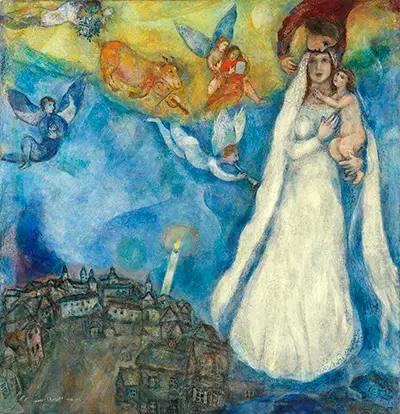He began to focus on this imaginative canvas in 1940, while briefly staying in the Provençal town of Gordes, where he went to seek asylum to avoid the challenging Nazi advance across Holland and Belgium into France. As he resumed works on this piece, he recoated some parts of the art piece he had previously sketched. It wasn't until 1942 that he completed this masterpiece while living in New York. In the bottom left of this oil on canvas painting, he indicated his signature and stated the dates (Marc Chagall 1938-1942), denoting the commencement and completion dates of the painting.
Clouds covering darkness and intrigue in an azure blue sky is at the forefront of the painting, and an angel duo. One of them is depicted in caerulean blue with arms across his chest, and the other angel is in white, in performance on the bugle. There are earthly and celestial figures in the sunshine overhead, possibly signifying the corporeal Nativity's cradle. There is the lover with a garland of floras, the cow or the ox is seen with a violin, an angel with a singer from the left towards the right. The outcome is rather poetic. This masterpiece is indeed a colourful lyric. The areas with colour range from blue at the middle to black at the base, and then a pleasant golden shade at the apex. The orbicular shaped settlement on the lower-left corner is Vitebsk, Chagall's ancestral village, and not Nazareth.
It is totally dark. It is night, and the radiance of Our Lady carries only one candle. At night, she emerges as the feminine saviour and as the redemption of an arduous black community. Conceivably, Chagall figured the best salvation for Jewish cities, now steadily persecuted, was a pure woman's love similar to that of Bella, his first wife. When he portrayed The Madonna of the Village, Chagall had existed for a long time in Christian France. This aided him to master the varying Christian aspects of the Madonna with Child. As in several Madonnas representations throughout centuries, the Virgin Mary reverently holds an infant in her hands. Still, as a Jew, Chagall had his version of Madonna. Looking carefully at this illustration, drawn on canvas, it seems that the Madonna displays the characteristics of Chagall's wife, Bella - wearing white, holding her daughter, Ida. Chagall is also present, and he is seen kissing the Madonna from directly above.
